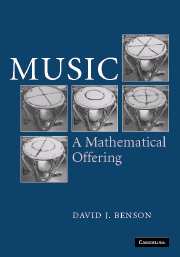Book contents
- Frontmatter
- Contents
- Preface
- Acknowledgements
- Introduction
- 1 Waves and harmonics
- 2 Fourier theory
- 3 A mathematician's guide to the orchestra
- 4 Consonance and dissonance
- 5 Scales and temperaments: the fivefold way
- 6 More scales and temperaments
- 7 Digital music
- 8 Synthesis
- 9 Symmetry in music
- Appendix A Bessel functions
- Appendix B Equal tempered scales
- Appendix C Frequency and MIDI chart
- Appendix D Intervals
- Appendix E Just, equal and meantone scales compared
- Appendix F Music theory
- Appendix G Recordings
- References
- Bibliography
- Index
6 - More scales and temperaments
Published online by Cambridge University Press: 05 March 2013
- Frontmatter
- Contents
- Preface
- Acknowledgements
- Introduction
- 1 Waves and harmonics
- 2 Fourier theory
- 3 A mathematician's guide to the orchestra
- 4 Consonance and dissonance
- 5 Scales and temperaments: the fivefold way
- 6 More scales and temperaments
- 7 Digital music
- 8 Synthesis
- 9 Symmetry in music
- Appendix A Bessel functions
- Appendix B Equal tempered scales
- Appendix C Frequency and MIDI chart
- Appendix D Intervals
- Appendix E Just, equal and meantone scales compared
- Appendix F Music theory
- Appendix G Recordings
- References
- Bibliography
- Index
Summary
Harry Partch's 43 tone and other just scales
In Section 5.5, we talked about just intonation in its narrowest sense. This involved building up a scale using ratios only involving the primes 2, 3 and 5, to obtain a twelve tone scale. Just intonation can be extended far beyond this limitation. The phrase super just is sometimes used to denote a scale formed with exact rational multiples for the intervals, but using primes other than the 2, 3 and 5. Most of these come from the twentieth century.
Harry Partch (see Figure 6.1) developed a just scale of 43 notes which he used in a number of his compositions. The tonic for his scale is G0. The scale is symmetric, in the sense that every interval upwards from G0 is also an interval downwards from G0.
The primes involved in Partch's scale are 2, 3, 5, 7 and 11. The terminology used by Partch to describe this is that his scale is based on the 11-limit, while the Pythagorean scale is based on the 3-limit and the just scales of Sections 5.5 and 5.10 are based on the 5-limit. More generally, if p is a prime, then a p-limit scale only uses rational numbers whose denominators and numerators factor as products of prime numbers less than or equal to p (repetitions are allowed).
- Type
- Chapter
- Information
- Music: A Mathematical Offering , pp. 210 - 244Publisher: Cambridge University PressPrint publication year: 2006



